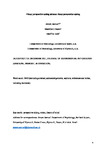Visual perspective taking without visual perspective taking
| dc.contributor.author | Samuel, Steven | |
| dc.date.accessioned | 2021-12-08T07:04:38Z | |
| dc.date.issued | 2022-04-01 | |
| dc.identifier.issn | 0278-7393 | |
| dc.identifier.issn | 1939-1285 | |
| dc.identifier.uri | http://hdl.handle.net/10026.1/18444 | |
| dc.description.abstract |
What happens when an observer takes an agent's visual perspective of a scene? We conducted a series of experiments designed to measure what proportion of adults take a stimulus-centered rather than agent-centered approach to a visual perspective taking task. Adults were presented with images of an agent looking at a number (69). From the perspective of the viewer, the number appeared upside down. We then asked participants what number the agent saw. An agent-centered approach, that is, one that takes into account the other's visual experience, should produce the correct answer "69". Even an egocentric error (i.e., the participant's own perspective) would provide the same correct response. We were interested in what proportion of participants would give the incorrect answer "96", which is best explained by a stimulus-centered rather than agent-centered strategy, namely "flipping" each digit one at a time from left to right. Crucially, such a strategy ignores the alternative visual perspective. We found that, on average, 12-21% of participants made this error. We discuss this finding in the context of the key questions around representation, content, and Theory of Mind in visual perspective taking. (PsycInfo Database Record (c) 2022 APA, all rights reserved). | |
| dc.format.extent | 959-965 | |
| dc.format.medium | Print-Electronic | |
| dc.language | en | |
| dc.language.iso | en | |
| dc.publisher | American Psychological Association | |
| dc.subject | perspective-taking | |
| dc.subject | vision | |
| dc.subject | theory of mind | |
| dc.title | Visual perspective taking without visual perspective taking | |
| dc.type | journal-article | |
| dc.type | Journal Article | |
| plymouth.author-url | https://www.webofscience.com/api/gateway?GWVersion=2&SrcApp=PARTNER_APP&SrcAuth=LinksAMR&KeyUT=WOS:000782231300001&DestLinkType=FullRecord&DestApp=ALL_WOS&UsrCustomerID=11bb513d99f797142bcfeffcc58ea008 | |
| plymouth.issue | 7 | |
| plymouth.volume | 48 | |
| plymouth.publication-status | Published online | |
| plymouth.journal | Journal of Experimental Psychology: Learning, Memory, and Cognition | |
| dc.identifier.doi | 10.1037/xlm0001121 | |
| plymouth.organisational-group | /Plymouth | |
| plymouth.organisational-group | /Plymouth/Faculty of Health | |
| plymouth.organisational-group | /Plymouth/Users by role | |
| plymouth.organisational-group | /Plymouth/Users by role/Academics | |
| dc.publisher.place | United States | |
| dcterms.dateAccepted | 2021-12-07 | |
| dc.rights.embargodate | 2022-6-30 | |
| dc.identifier.eissn | 1939-1285 | |
| dc.rights.embargoperiod | Not known | |
| rioxxterms.versionofrecord | 10.1037/xlm0001121 | |
| rioxxterms.licenseref.uri | http://www.rioxx.net/licenses/all-rights-reserved | |
| rioxxterms.type | Journal Article/Review |


